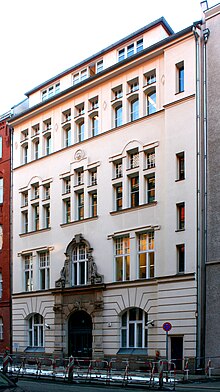Hochschule für die Wissenschaft des Judentums
This article includes a improve this article by introducing more precise citations. (April 2014) ) |

Hochschule für die Wissenschaft des Judentums, or Higher Institute for Jewish Studies, was a
History
Geiger's "General Introduction to the Science of Judaism," "Introduction to the Biblical Writings" and "Lectures on Pirḳe Abot" were originally delivered as lectures at the seminary. Some of the best German-Jewish teachers taught there in the spirit of the Wissenschaft des Judentums movement: Hanoch Albeck, Ismar Elbogen, Julius Grünthal, Julius Guttmann, Franz Rosenthal, Harry Torczyner, and Leo Baeck.
Moritz Steinschneider referred to the Hochschule as a "new ghetto of Jewish learning," which he felt could ultimately not produce the standards of scholarship achieved in the university setting.
Officially the institution was not affiliated with a movement or denomination. It sought free inquiry and research without any restrictions. It stood for a conservative Judaism, but its main object was the scientific study of things Jewish, freed as far as possible from denominational disputes. There was no religious test for professors but it was assumed that all of the faculty lived according to the Jewish tradition and were fluent in Hebrew. As the school was never dependent on any religious or public organization, the board was constantly engaged in raising money from wealthy contributors, sponsors of scholarly "chairs" and scholarships.
In 1872, the first year, there were only 12 students, including four women. In 1921, there were 63 full-time and 45 part-time students enrolled in the Hochschule. Many of the students came from Eastern European countries, notably
Notable alumni
- Second World War, he settled in London, UK, where he served as the chairman of the World Union for Progressive Judaism.
- Arthur Biram (1878–1967), philosopher, philologist, and educator, who emigrated to Ottoman Palestine in 1913
- cardiologistin Israel, where he founded the Jerusalem Academy of Medicine
- Mordecai Ehrenpreis
- Emil L. Fackenheim
- Abraham Joshua Heschel
- Ellen Littmann
- Regina Jonas
- Alice Lucas
- Philip Magnus
- Arno Nadel
- Claude Montefiore
- Samuel Poznanski
- Herman Schaalman (1916–2017), who became senior rabbi at the Emanuel Congregation of Chicago and also an interfaith activist
- Solomon Schecter
- Max Schloessinger
- first elected Russian Parliament for the Constitutional Democratic Partyin 1906.
- Selma Stern (1890–1981), one of the first women in Germany to become a professional historian; a research fellow at the Akademie für die Wissenschaft des Judentums which was founded at the Hochschule in 1919
- PhD in 1929.[1] He was rabbi, for 36 years, at Temple Beth El, a Reform synagogue in Madison, Wisconsin.[2]
- Chief Rabbi of Vienna
- Werner van der Zyl (1902–1984), who became a rabbi in Berlin and in London, where he was the prime mover and first director of studies of what was to become the Leo Baeck College
- Miriam Yalan-Shteklis (1900–1984), writer and poet
References
- ^ Biographical guide to Forest Hill Cemetery: the ordinary and famous women and men who shaped Madison and the world. Historic Madison, Inc. 2002. p. 343. Retrieved 28 October 2012.
- ISBN 978-0-313-28856-2. Retrieved 28 October 2012.
Further reading
- Lehranstalt für die Wissenschaft des Judenthums: Rückblick auf die ersten fünfundzwanzig Jahre (1872–97), Berlin, 1897.
- Seidel, Esther (2002). Women Pioneers of Jewish Learning: Ruth Liebrecht and Her Companions at the 'Hochschule für die Wissenschaft des Judentums' in Berlin 1930–1934, ISBN 978-3-934658-32-5.
External links
- Popular article on the history of the institution
 This article incorporates text from a publication now in the public domain: Singer, Isidore; et al., eds. (1901–1906). "Lehranstalt für die Wissenschaft des Judentums". The Jewish Encyclopedia. New York: Funk & Wagnalls.
This article incorporates text from a publication now in the public domain: Singer, Isidore; et al., eds. (1901–1906). "Lehranstalt für die Wissenschaft des Judentums". The Jewish Encyclopedia. New York: Funk & Wagnalls.- Bookstamp of the Bibliothek der Hochschule für die Wissenschaft des Judentums (Rare Books of the Shimeon Brisman Collection in Jewish Studies, Washington University)
- Bookstamp of the Bibliothek der Lehranstalt für die Wissenschaft des Judentums (Rare Books of the Shimeon Brisman Collection in Jewish Studies, Washington University)
